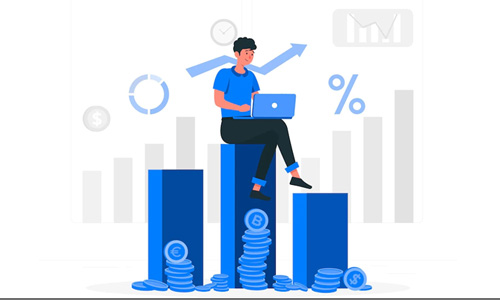Best Fixed Return Investment Plans in 2025
Invest smart today for a better tomorrow
In 2023, as the world continues to experience financial shifts, the importance of wise investment in one's life has become paramount. For those with a fixed income, the challenge often lies in finding a stable and secure way to grow their money.
With a wide range of options available, selecting the right fixed return investment can certainly become daunting. It is essential to assess these options carefully, especially if you're seeking consistent returns without significant risks.
Table of Content
This article sheds light on the best fixed income investment options this year. By exploring the most promising fixed return investment plans, you will be able to make informed decisions regarding your investments.
Retirement Plan
A retirement plan serves as a combined insurance and investment strategy that ensures a stable financial future. It's designed in such a way that individuals contribute a fixed amount regularly over a specified duration. By the end of this period, the accumulated amount is systematically channelled back to the individual, offering a consistent income in the form of annuities.
Key Features
- Regular Premiums: The plan's backbone is the periodic premium paid by the insured individual to the insurance company throughout the plan's duration. These payments build the foundation for future benefits.
- Accumulation of Corpus: Over the policy's lifespan, these regular premiums culminate into a significant corpus. This is not just a mere saving but an investment for the golden years, ensuring that one’s retired life is as comfortable as possible.
- Annuity Payouts: Once the policy matures, the insured starts receiving annuity payments. These payments are like regular income instalments, ensuring that even after retirement, there's a steady flow of funds to cater to one's needs.
- Death Benefit: If the insured passes away during the policy period, the retirement plan doesn’t go to waste. Instead, the predefined sum assured is handed over to the designated beneficiary.
- Safeguard against Post-Retirement Financial Worries: The primary aim of this plan is to ensure that individuals have a reliable financial source once their regular salary stops. This not only offers monetary comfort but also peace of mind in the later years of life.
Bonds
Bonds serve as a vital fixed return investment through which large entities — corporations as well as government agencies — procure necessary funds for their expansive ventures and initiatives. By investing in bonds, individuals essentially extend a loan to these entities, receiving a certificate of debt in return.
Key Aspects
- Role of the Investor: When you purchase a bond, you're not merely buying a piece of paper but essentially stepping in as a creditor to the issuer, which could be a corporation or a government body.
- Bond Issuance: In reciprocation for the lent money, the investor is presented with a bond. This acts as a formal promise that the issuer owes the investor the borrowed amount plus any specified interest.
- Interest Payments: One of the attractions of bonds is the provision for periodic interest payments, often termed as coupon payments. Depending on the bond's terms, these payments provide a regular income for the investor based on the issuer's profitability.
- Principal Repayment: Upon reaching the bond's maturity date, the investor not only continues to benefit from interest payments but also gets the initial amount they lent, known as the principal.
- Holding Strategy: For optimal benefits, a common strategy among seasoned investors is to retain the bond until its maturity. This ensures receipt of all due interest payments along with the guaranteed return of the principal amount.
- Secure Investment: Bonds, especially those issued by government bodies, are often perceived as less volatile compared to other investments, offering a degree of financial security and predictability.
Monthly Income Plan (MIPs)
Monthly Income Plans (MIP) stand out as a prominent choice for those looking at fixed income investment opportunities. Structured as a debt-biased hybrid mutual fund, they offer investors periodic financial returns each month.
As with many market-related instruments, the outcomes of MIPs are not set in stone — they echo the fund's market performance.
Key Highlights
- Nature of Investment: MIPs primarily revolve around debt instruments, blending them with a fraction of equity. This structure ensures stability while also providing room for potential growth.
- Market-Linked Returns: The absence of guaranteed returns in MIPs might sound daunting, but it's essential to understand that they are linked to market dynamics. This means the returns are reflective of the fund's overall performance in the market.
- Appeal to Cautious Investors: Due to their foundational structure, MIPs are particularly appealing to conservative investors. They offer an avenue to potentially outpace inflation while maintaining a relatively low-risk profile overall.
- Enhanced Returns: One of the standout features of MIPs is their capability to generate returns, typically ranging between 11-14%. This gives them a commendable edge over traditional Fixed Deposits (FDs).
- No Investment Ceiling: MIPs come with the advantage of flexibility. As investors aren't restricted by a maximum investment limit, they can invest as per their financial capabilities and goals.
- Absence of Lock-in Period: Unlike some investment options, MIPs don’t bind the investor with a specific lock-in duration. This feature ensures greater liquidity and freedom for the investor, especially if they need to make financial adjustments or reallocations.
Public Provident Fund
Public Provident Fund (PPF) remains a preferred fixed return investment choice for those who favour financial stability over high-risk ventures. Known for its dependable returns, PPF offers an appealing blend of safety and growth for investors.
Key Features
- Risk Profile: PPF is especially attractive to those who tend to be risk-averse. Given its government-backed nature, it provides a secure environment for one's funds.
- Guaranteed Returns: One of the salient aspects of investing in a PPF is the assurance of returns. Historically, the yield has fluctuated around a respectable 8.5% to 9%, making it a lucrative option for long-term growth.
- Flexibility in Investment Amount: While many investment avenues might impose a cap on the maximum amount one can invest, PPF stands apart. There's no upper boundary on the investment sum, allowing individuals the freedom to contribute according to their financial planning and capabilities.
- Long-Term Growth: PPF accounts have a maturity period of 15 years, making them an excellent choice for individuals looking for long-term financial planning tools. This duration ensures compounded growth, leading to substantial wealth accumulation over time.
Bank Fixed Deposits (FDs)
Fixed deposits (FDs), similar to standard savings accounts, come with the added advantage of delivering high interest rates. A distinct feature of FDs is the mandatory lock-in duration during which funds remain untouched.
FDs, particularly those offered by leading banks, promise assured returns and ensure that the principal sum remains safeguarded. They are pretty popular as a source of investment, particularly among investors who prioritise security over risk.
Key Characteristics
- Nature of Investment: FDs function similarly to traditional savings accounts. However, they differ by offering high interest rates, ensuring a better yield over the deposit tenure.
- Lock-in Duration: FDs come with a specified maturity period. During this period, investors are typically discouraged from withdrawing their funds. This ensures that the money accrues the maximum possible interest.
- Guaranteed Returns: One of the standout features of FDs, especially those from reputed banks, is the assurance of returns. Investors can be confident that their money will grow at the promised rate without the fluctuations seen in riskier investments.
- Safety of Principal: Along with the interest, the core amount deposited, i.e. the principal, remains safe in FDs. This dual assurance of interest and principal safety makes FDs a go-to option for many.
- Increasing Popularity: Despite the emergence of various investment avenues, FDs continue to hold their ground. Their reliability makes them a favourite, particularly among those who want to avoid market-linked uncertainties.
Wrapping Up
The rapidly evolving financial landscape emphasises the importance of prudent investment, especially for those with fixed incomes. A myriad of fixed return investment options can be found, each with its unique features and benefits.
From the reliable Public Provident Fund to the tried-and-true nature of Bank Fixed Deposits, there's something for every risk profile. Bonds and Retirement Plans offer stability and predictable payouts, while Monthly Income Plans cater to those willing to bear market dynamics.
To maximise benefits from these best fixed income investments in India, it's crucial to understand and align them with one's financial goals and risk tolerance.

















.jpg)